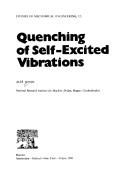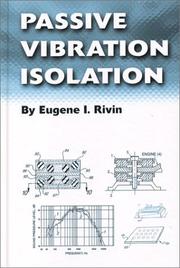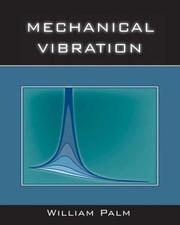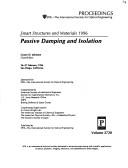| Listing 1 - 10 of 136 | << page >> |
Sort by
|
Book
ISBN: 0738143960 Year: 1980 Publisher: New York : Institute of Electrical and Electronics Engineers (IEEE),
Abstract | Keywords | Export | Availability | Bookmark
 Loading...
Loading...Choose an application
- Reference Manager
- EndNote
- RefWorks (Direct export to RefWorks)
The basic engineering approach to the control of vibration of overhead conductors is to compare, at an acceptable amplitude, the wind power input with the power dissipated by the conductor and supporting structures and hardware. The difference between these two quantities is the amount of power that ideally should be dissipated by a vibration damping system, when attached to a single conductor at one or more appropriate locations. This guide describes the procedures for determining the performance of vibration damping systems. It is hoped that the guide will assist in standardizing the methods involved and that it will result in more reliable basic information on damper dissipation characteristics, on a basis that is consistent with the technical requirements, and that is universally recognized and accepted.
Book
Year: 1906 Publisher: Stuttgart : Kröner Verlag,
Abstract | Keywords | Export | Availability | Bookmark
 Loading...
Loading...Choose an application
- Reference Manager
- EndNote
- RefWorks (Direct export to RefWorks)
Book
ISBN: 0738103640 Year: 1993 Publisher: New York : Institute of Electrical and Electronics Engineers (IEEE),
Abstract | Keywords | Export | Availability | Bookmark
 Loading...
Loading...Choose an application
- Reference Manager
- EndNote
- RefWorks (Direct export to RefWorks)
The current methodologies, including apparatus, procedures, and measurement accuracies, for determining the dynamic characteristics of vibration dampers and damping systems are described. Some basic guidance is provided regarding a given method¿s strengths and weaknesses. The methodologies and procedures described are applicable to indoor testing only. Keywords: aeolian, decay method, forced response method, inverse standing wave ratio (ISWR) method, overhead conductors, power dissipation characteristics, power method, vibration dampers.
Book
Year: 1959 Publisher: Berlin : Akademie-Verlag,
Abstract | Keywords | Export | Availability | Bookmark
 Loading...
Loading...Choose an application
- Reference Manager
- EndNote
- RefWorks (Direct export to RefWorks)
Vibration. --- Damping (Mechanics). --- Friction.
Book
Year: 1971 Publisher: Bruxelles : ABEM,
Abstract | Keywords | Export | Availability | Bookmark
 Loading...
Loading...Choose an application
- Reference Manager
- EndNote
- RefWorks (Direct export to RefWorks)
Book
ISBN: 0198591454 Year: 1975 Publisher: Oxford Oxford university press
Abstract | Keywords | Export | Availability | Bookmark
 Loading...
Loading...Choose an application
- Reference Manager
- EndNote
- RefWorks (Direct export to RefWorks)

ISBN: 0444987215 Year: 1991 Publisher: Amsterdam Elsevier
Abstract | Keywords | Export | Availability | Bookmark
 Loading...
Loading...Choose an application
- Reference Manager
- EndNote
- RefWorks (Direct export to RefWorks)

ISBN: 079180187X Year: 2003 Publisher: New York (N.Y.): ASME Press
Abstract | Keywords | Export | Availability | Bookmark
 Loading...
Loading...Choose an application
- Reference Manager
- EndNote
- RefWorks (Direct export to RefWorks)

ISBN: 0471345555 9780471345558 Year: 2007 Publisher: New York Wiley
Abstract | Keywords | Export | Availability | Bookmark
 Loading...
Loading...Choose an application
- Reference Manager
- EndNote
- RefWorks (Direct export to RefWorks)

ISBN: 0819420956 Year: 1996 Publisher: Bellingham SPIE
Abstract | Keywords | Export | Availability | Bookmark
 Loading...
Loading...Choose an application
- Reference Manager
- EndNote
- RefWorks (Direct export to RefWorks)
| Listing 1 - 10 of 136 | << page >> |
Sort by
|

 Search
Search Feedback
Feedback About UniCat
About UniCat  Help
Help News
News